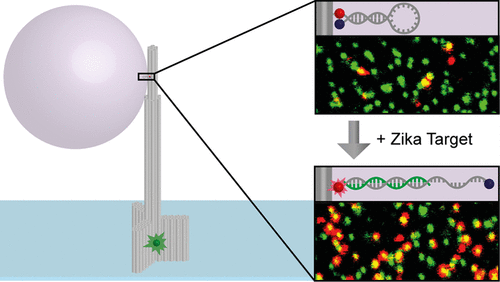当前位置:
X-MOL 学术
›
Anal. Chem.
›
论文详情
Our official English website, www.x-mol.net, welcomes your
feedback! (Note: you will need to create a separate account there.)
Optical Nanoantenna for Single Molecule-Based Detection of Zika Virus Nucleic Acids without Molecular Multiplication
Analytical Chemistry ( IF 6.7 ) Pub Date : 2017-11-22 00:00:00 , DOI: 10.1021/acs.analchem.7b04082 Sarah E. Ochmann 1 , Carolin Vietz 1 , Kateryna Trofymchuk 1 , Guillermo P. Acuna 1 , Birka Lalkens 1 , Philip Tinnefeld 1, 2
Analytical Chemistry ( IF 6.7 ) Pub Date : 2017-11-22 00:00:00 , DOI: 10.1021/acs.analchem.7b04082 Sarah E. Ochmann 1 , Carolin Vietz 1 , Kateryna Trofymchuk 1 , Guillermo P. Acuna 1 , Birka Lalkens 1 , Philip Tinnefeld 1, 2
Affiliation

|
Because of the limited signal-to-background ratio, molecular diagnostics requires molecular amplification of the target molecules or molecular signal amplification after target recognition. For direct molecular detection, we demonstrate a purely physical fluorescence enhancement process which can elevate the fluorescence signal of single fluorescent dyes by several orders of magnitude. To this end, DNA origami-based optical antennas with a height of around 125 nm are used, which utilize metallic nanoparticles to create a hotspot where fluorescence signals are enhanced by plasmonic effects. By equipping the hotspot with a molecular beacon-like structure, we combine the plasmonic signal enhancement with a specific signal generation, leading to an enhanced and therefore easy to detect signal only in the presence of the specific target nucleic acid. Exemplified with Zika virus detection, we show the applicability of this approach by detecting Zika-specific artificial DNA and RNA both in buffer and in heat-inactivated human blood serum. We show the sensitivity against small nucleotide variations of this approach, allowing the discrimination of closely related pathogens. Furthermore, we show how the modularity offered by DNA nanotechnology enables multiplexing by incorporating orthogonal fluorescent labels for the simultaneous detection of different sequences. The achieved signal enhancement will allow technically simplified signal detection, paving the way for single molecule-based point-of-care diagnosis.
中文翻译:

光学纳米天线,无需分子倍增,即可单分子检测寨卡病毒核酸
由于有限的信噪比,分子诊断需要目标分子的分子扩增或目标识别后的分子信号扩增。对于直接分子检测,我们证明了纯物理荧光增强过程可以将单个荧光染料的荧光信号提高几个数量级。为此,使用了高度约为125 nm的基于DNA折纸的光学天线,该天线利用金属纳米粒子形成热点,在该热点处,等离子体效应增强了荧光信号。通过为热点配备分子信标样结构,我们将等离子体信号增强与特定信号生成结合在一起,从而导致增强信号,因此仅在存在特定目标核酸的情况下才易于检测信号。以寨卡病毒检测为例,我们通过在缓冲液和热灭活的人血清中检测寨卡病毒特异性人工DNA和RNA来显示该方法的适用性。我们展示了这种方法对小核苷酸变异的敏感性,从而可以区分密切相关的病原体。此外,我们展示了DNA纳米技术提供的模块性如何通过并入正交荧光标记同时检测不同序列来实现多路复用。所实现的信号增强将使技术上简化的信号检测成为可能,从而为基于单分子的即时诊断服务铺平了道路。我们展示了这种方法对小核苷酸变异的敏感性,从而可以区分密切相关的病原体。此外,我们展示了DNA纳米技术提供的模块性如何通过并入正交荧光标记同时检测不同序列来实现多路复用。所实现的信号增强将使技术上简化的信号检测成为可能,从而为基于单分子的即时诊断服务铺平了道路。我们展示了这种方法对小核苷酸变异的敏感性,从而可以区分密切相关的病原体。此外,我们展示了DNA纳米技术提供的模块性如何通过并入正交荧光标记同时检测不同序列来实现多路复用。所实现的信号增强将使技术上简化的信号检测成为可能,从而为基于单分子的即时诊断服务铺平了道路。
更新日期:2017-11-22
中文翻译:

光学纳米天线,无需分子倍增,即可单分子检测寨卡病毒核酸
由于有限的信噪比,分子诊断需要目标分子的分子扩增或目标识别后的分子信号扩增。对于直接分子检测,我们证明了纯物理荧光增强过程可以将单个荧光染料的荧光信号提高几个数量级。为此,使用了高度约为125 nm的基于DNA折纸的光学天线,该天线利用金属纳米粒子形成热点,在该热点处,等离子体效应增强了荧光信号。通过为热点配备分子信标样结构,我们将等离子体信号增强与特定信号生成结合在一起,从而导致增强信号,因此仅在存在特定目标核酸的情况下才易于检测信号。以寨卡病毒检测为例,我们通过在缓冲液和热灭活的人血清中检测寨卡病毒特异性人工DNA和RNA来显示该方法的适用性。我们展示了这种方法对小核苷酸变异的敏感性,从而可以区分密切相关的病原体。此外,我们展示了DNA纳米技术提供的模块性如何通过并入正交荧光标记同时检测不同序列来实现多路复用。所实现的信号增强将使技术上简化的信号检测成为可能,从而为基于单分子的即时诊断服务铺平了道路。我们展示了这种方法对小核苷酸变异的敏感性,从而可以区分密切相关的病原体。此外,我们展示了DNA纳米技术提供的模块性如何通过并入正交荧光标记同时检测不同序列来实现多路复用。所实现的信号增强将使技术上简化的信号检测成为可能,从而为基于单分子的即时诊断服务铺平了道路。我们展示了这种方法对小核苷酸变异的敏感性,从而可以区分密切相关的病原体。此外,我们展示了DNA纳米技术提供的模块性如何通过并入正交荧光标记同时检测不同序列来实现多路复用。所实现的信号增强将使技术上简化的信号检测成为可能,从而为基于单分子的即时诊断服务铺平了道路。











































 京公网安备 11010802027423号
京公网安备 11010802027423号